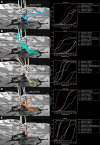Establishing connectivity through microdissections of midbrain stimulation-related neural circuits
- PMID: 38808482
- PMCID: PMC11370807
- DOI: 10.1093/brain/awae173
Establishing connectivity through microdissections of midbrain stimulation-related neural circuits
Abstract
Comprehensive understanding of the neural circuits involving the ventral tegmental area is essential for elucidating the anatomofunctional mechanisms governing human behaviour, in addition to the therapeutic and adverse effects of deep brain stimulation for neuropsychiatric diseases. Although the ventral tegmental area has been targeted successfully with deep brain stimulation for different neuropsychiatric diseases, the axonal connectivity of the region is not fully understood. Here, using fibre microdissections in human cadaveric hemispheres, population-based high-definition fibre tractography and previously reported deep brain stimulation hotspots, we find that the ventral tegmental area participates in an intricate network involving the serotonergic pontine nuclei, basal ganglia, limbic system, basal forebrain and prefrontal cortex, which is implicated in the treatment of obsessive-compulsive disorder, major depressive disorder, Alzheimer's disease, cluster headaches and aggressive behaviours.
Keywords: deep brain stimulation; fibre tractography; neuropsychiatric neural circuits; ventral tegmental area.
© The Author(s) 2024. Published by Oxford University Press on behalf of the Guarantors of Brain.
Conflict of interest statement
V.A.C., as an employee of University of Freiburg, listed by the institution as inventor, has filed a US provisional patent application generally related to highly focused DBS in the treatment of obsessive–compulsive disorder (US patent application number 63/253,740). All other authors report no biomedical financial interests or potential competing interests. C.G.H. is a paid consultant for Hemerion Therapeutics, Synaptive Medical, Stryker Corp. and Integra. A.M.L. is a consultant to Abbott, Boston Scientific, Insightec and Medtronic and is Scientific Director at Functional Neuromodulation. V.A.C. receives a collaborative grant from BrainLab (Munich, Germany); he is a consultant for Ceregate (Munich, Germany), Cortec (Freiburg, Germany), ALEVA (Lausanne, Switzerland) and Inbrain (Barcelona, Spain); and he has ongoing investigator initiated trials (IITs) with Boston Scientific (USA) and has received personal honoraria and travel support for lecture work from Boston Scientific (USA), UNEEG and PRECISIS.
Figures








References
-
- Morales M, Margolis EB. Ventral tegmental area: Cellular heterogeneity, connectivity and behaviour. Nat Rev Neurosci. 2017;18:73–85. - PubMed
MeSH terms
Grants and funding
LinkOut - more resources
Full Text Sources

